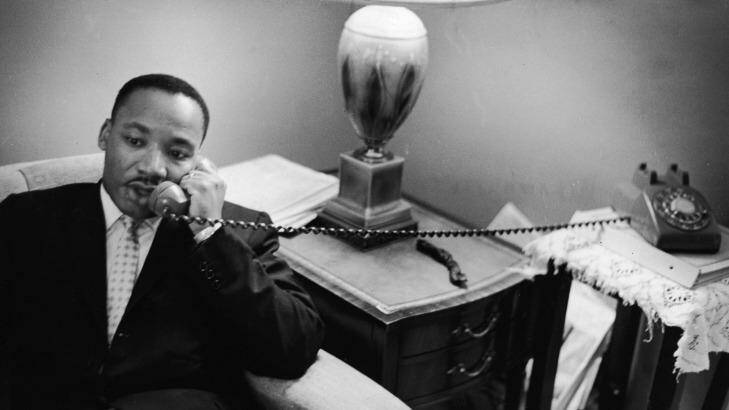



Turning a full circle, local guide Meg Lewis explains why she calls it her "360 degree" view of history. On this spot, she explains, stood one of the slave markets where, in the 1850s, "able field hands" were bought and sold for $US1500 each and "skilled artisans" for twice as much.
Subscribe now for unlimited access.
$0/
(min cost $0)
or signup to continue reading
Over there, across the street, is the site of the office from which the telegram was sent to fire on Fort Sumter, thereby starting a Civil War in which 620,000 Americans lost their lives.
Up yonder, gleaming brightly, is the State Capitol where the Deep South formed the Confederacy and seceded from the United States. Nearby, is the first White House of the rebel states.
And in between stands the church where civil rights leader Dr Martin Luther King was once pastor, and the bus stop where 60 years ago a local black woman called Rosa Parks momentously refused to give up her seat to a white person.
Wow! Wave goodbye to Broadway, New York. Pack away your camera and put Pennsylvania Avenue, Washington, on hold. When it comes to American history Dexter Avenue, Montgomery, Alabama, is darned hard to beat.
It is day four of a Deep South road trip, devised by Travel South USA, which has already exposed us to the colourful attractions of Nashville, Muscle Shoals and Birmingham.
By contrast, Montgomery seems quieter (despite the existence of Sous Le Terre, an underground nightclub that doesn't open until midnight), slower, and, well, more cerebral, more stately – as befits a state capital, perhaps.
The First White House of the Confederacy offers a fascinating insight into the life and times of inaugural president Jefferson Davis and his family. It was here, in 1861, that he prosecuted the South's campaign, and his wife threw lavish parties.
In places, the elegant but comfortable home looks like a dolls' house. As Czech-born guide Eva Newman reminds us, 150 years ago people were much shorter, though Davis, who stood almost six foot, or 182cm, had his own giant bed.
Neither Davis, nor his Italianate "White House", lasted long: the capital was quickly moved to Richmond, Virginia, to be closer to the fighting, and Davis was captured and imprisoned until the war ended in 1865.
Visitors wanting to learn and see more of where the war was fought and lost should pick up the Alabama Civil War Trail leaflet, which offers more than 50 local sites ranging from museums to ironworks, armouries to cemeteries.
Appropriately, lunch is taken at the Davis Café, an unassuming, clapboard – indeed clapped-out – building, seemingly held together by industrial-strength tape.
But the food is to fight, if not die for. A local favourite is "meat and three"; that is, chicken, turkey, fish or BBQ ribs with three vegetables including tomatoes, collard greens, fresh purple hull peas, mashed yams and green lima beans.
The atmosphere is treacly hot, the helpings huge and the desserts miles off the calorie counter: banana pudding, sweet potato pie and four types of cake: pound, lemon, red velvet and yellow with chocolate icing.
Full, if not fighting fit, we return to Dexter Avenue to tour the Memorial Baptist Church, where as a young pastor Dr Martin Luther King was soon thrust into the civil rights movement.
We are welcomed by Wanda Howard Battle, with a hug and an invitation to join in a circle with her, hold hands, and sing a suitably uplifting song. From there we are shown the desk where Dr King did his paper work, the podium where he delivered sermons and fiery speeches
After another song and sway with the wonderfully hospitable Wanda, we drive away from the civic centre, to the Dexter Parsonage, where Dr King and his young family lived between 1954 and 1960.
It all looks very 1950s homely: a statement of domestic harmony, more or less, built round a comfy couch, a record player, a desk, a double bed, and a set of cups, saucers and other crockery.
Here, too, is the Bakelite telephone on which he received death threats from his racist enemies; a reminder that even in his modest house on quiet 315 South Jackson Street, Dr King and his family could not feel wholly safe.
Many of his battles fought and won, Dr King was to die in 1968, assassinated in a Memphis, Tennessee, motel. He was just 39.
There is more, much more, to see, do and enjoy in Montgomery. A short walk from the banks of the Alabama River is a museum dedicated to legendary country music singer Hank Williams, who also died young, at 29, in the back of his sky-blue Cadillac.
Not far from downtown, in the upscale Cloverdale, is the period house where literary legends F. Scott and Zelda Fitzgerald briefly lived in the 1930s.
The leafy suburb also boasts excellent restaurants, such as A & P Social, which sources fresh crab, shrimp, oysters, snapper, tuna and grouper from the Gulf Coast, and high quality meat and veggies from farmers in the local Black Belt.
Pick your time right and you can also enjoy one of Montgomery's less likely attractions, an annual drama festival dedicated to the works of "The Bard", called "Shakespeare Y'all!"
TRIP NOTES
MORE INFORMATION
www.travelsouthusa.com; www.alabama.travel
GETTING THERE
Qantas overs a non-stop flight from Sydney to Dallas-Fort Worth, with code-share connections with several Deep South destinations.
STAYING THERE
The Deep South offers a wide range of hotels, motels and homestays, ranging in price from US $25 to US $500 a night. The author stayed at the Westin Renaissance Montgomery Hotel.
John Huxley was a guest of Travel South USA and Qantas.

